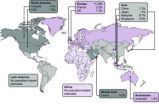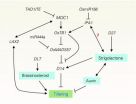(Press-News.org) The foundation of the human population explosion, commonly attributed to a sudden surge in industrialization and public health during the 18th and 19th centuries, was actually laid as far back as 2,000 years ago, suggests an extended model of detailed demographic and archeological data.
The Public Library of Science One (PLOS ONE) recently published the analytical framework developed by Aaron Stutz, an associate professor of anthropology at Emory University's Oxford College.
"The industrial revolution and public health improvements were proximate reasons that more people lived longer," Stutz says. "If you dig further in the past, however, the data suggest that a critical threshold of political and economic organization set the stage 1,500 to 2,000 years ago, around the start of the Common Era. The resulting political-economic balance was the tipping point for economies of scale: It created a range of opportunities enabling more people to get resources, form successful families, and generate enough capital to transfer to the next generation."
Population dynamics have been a hot topic since 1798, when English scholar Thomas Robert Malthus published his controversial essay that population booms in times of plenty will inevitably be checked by famine and disease. "The power of population is indefinitely greater than the power in the earth to produce subsistence for man," he wrote. The so-called Malthusian Catastrophe theory was penned just prior to the global census size reaching one billion.
While it took hundreds of thousands of years for humans to reach that one billion milestone, it took only another 120 years for humanity to double to two billion. And during the past 50 years, the human population has surged to near eight billion.
"It's mind-boggling," Stutz says. "The human population has not behaved like any other animal population. We haven't stayed in any kind of equilibrium with what we would consider a typical ecological niche."
Economic historians and demographers have focused on societal changes that occurred during the Industrial Revolution as the explanation for this super-exponential population growth. An archeologist by training, Stutz wanted to explore further back in time.
"Archeologists are interested in looking at much earlier changes in human society," Stutz says. "In addition to looking at data, we dig up things like people's houses, community courtyards, agricultural fields, harbors and so on. That gives us this sort of holistic view of how human society and the environment influence one another over time."
His analysis found that that the potential for the human population to burgeon despite environmental degradation, conflict and disease could be traced to a subtle interaction between competition and organization. At a certain tipping point, this interaction created opportunities for individuals to gain more control over their lives and prosper, opening the door to economies of scale.
Stutz cites the Roman Empire, which spanned 500 years, from just before the Common Era to 476 CE, as a classic example of passing through this threshold. One of the largest and most prosperous empires in history, it is noteworthy for economic and political organization, literature, and advances in architecture and engineering.
And yet, on an individual level, life was not necessarily so grand. Farm laborers and miners were ground into short, miserable lives to produce all those surplus goods for trading and empire building. And large numbers of young males had to serve in the military to ward off rebellions.
"The vast majority of people who lived under Roman rule had a life expectancy into their late 20s or early 30s," Stutz says. "A huge swath of the population was feeding, quite literally, the dynamism that was taking place in terms of economic and political development. Their labor increased the potential for providing more democracy and competition on the smaller scale. That, in turn, led to a more complex, inter-generational dynamic, making it possible to better care for offspring and even transfer resources to them."
The tipping point had been reached, Stutz says, and the trend continued despite the collapse of the Roman Empire.
"The increasingly complex and decentralized economic and political entities that were built up around the world from the beginning of the Common Era to 1500 CE created enough opportunities for individuals, states and massive powers like England, France and China to take advantage of the potential for economies of scale," Stutz says.
This revised framework for the underpinnings of human population dynamics could lead to better understanding of how economic and political organization is affecting modern-day society, he adds.
"We might wind up being back in a situation where a growing part of the population is basically providing labor to sustain a minority," Stutz says. "You could certainly point to the sweat shops in the developing world. Another potential example is the growing income inequality that's been well-documented in the United States over the last couple of decades."
INFORMATION: END
Modern population boom traced to pre-industrial roots
2014-09-02
ELSE PRESS RELEASES FROM THIS DATE:
New name for symptoms associated with menopause
2014-09-02
Experts who reviewed the terminology associated with genitourinary tract symptoms related to menopause—currently referred to as vulvovaginal atrophy—have agreed that the term genitourinary syndrome of menopause (GSM) is a medically more accurate, all-encompassing, and a more publicly acceptable term. Their thoughts are published in a recent Journal of Sexual Medicine article.
Going forward, GSM will encompass a collection of symptoms and signs associated with a decrease in estrogen and other sex steroids and may include genital symptoms of dryness, burning, and irritation; ...
Extinctions during human era worse than thought
2014-09-02
PROVIDENCE, R.I. [Brown University] — It's hard to comprehend how bad the current rate of species extinction around the world has become without knowing what it was before people came along. The newest estimate is that the pre-human rate was 10 times lower than scientists had thought, which means that the current level is 10 times worse.
Extinctions are about 1,000 times more frequent now than in the 60 million years before people came along. The explanation from lead author Jurriaan de Vos, a Brown University postdoctoral researcher, senior author Stuart Pimm, a Duke ...
Time to take notice and tackle heart failure
2014-09-02
Experts have sounded a call to action for policy makers at local, national, and international levels to promote heart failure prevention, improve heart failure awareness among healthcare professionals, ensure equity of care for all patients with heart failure, support and empower patients and their caregivers, and promote heart failure research.
Despite the increasing numbers of people living with and dying from heart failure, awareness of the disease is low among the public, politicians, and even some healthcare professionals. Although there is no cure for heart failure, ...
Chinese scientists' team efforts in dissecting rice complex agronomic traits in recent years
2014-09-02
Rice is a main food source for more than half of the global population and is a model plant for genome-based research.
Since the turn of the century, Chinese scientists have embarked on a "Long March" toward more intricate understanding of the complex agronomic traits of rice, spurred in part by the completion of the draft genome sequence of the indica variety 93-11 and a fine sequence analysis of chromosome 4 of the japonica variety Nipponbare.
These researchers "have made crucial contributions to international efforts in sequencing the rice genome," report Jianru Zuo ...
Childhood trauma could lead to adult obesity
2014-09-02
Being subjected to abuse during childhood entails a markedly increased risk of developing obesity as an adult. This is the conclusion of a meta-analysis carried out on previous studies, which included a total of 112,000 participants. The analysis was conducted by researchers at Karolinska Institutet in Sweden, and has been published in the journal Obesity Reviews.
"The study clearly shows that difficult life events leave traces which can manifest as disease much later in life. The mechanisms behind this process include stress, negative patterns of thought and emotions, ...
Scientists obtain new data on the weather 10,000 years ago from sediments of a lake in Sierra Nevada
2014-09-02
A research project which counts with the participation of the University of Granada has revealed new data on the climate change that took place in the Iberian Peninsula around the mid Holocene (around 6.000 years ago), when the amount of atmospheric dust coming from the Sahara increased. The data came from a study of the sediments found in an Alpine lake in Sierra Nevada (Granada)
This study, published in the journal Chemical Geology, is based on the sedimentation of atmospheric dust from the Sahara, a very frequent phenomenon in the South of the Iberian Peninsula. This ...
Muslim headscarf may buffer against negative body image among women
2014-09-02
Researchers have found that British Muslim women who wear a hijab generally have more positive body image, are less reliant on media messages about beauty ideals, and place less importance on appearance than those who do not wear a hijab. These effects appear to be driven by use of a hijab specifically, rather than religiosity.
"While we shouldn't assume that wearing the hijab immunizes Muslim women from negative body image, our results do suggest that wearing the hijab may help some women reject prescriptive beauty ideals," said Dr. Viren Swami, lead author of the British ...
In pro baseball pitchers, weak core linked to more missed days
2014-09-02
COLUMBUS, Ohio – New research suggests that professional baseball pitchers with poor core stability are more likely to miss 30 or more days in a single season because of injury than are pitchers who have good control of muscles in their lower back and pelvis.
In the study, 347 pitchers were assessed for lumbopelvic control during spring training. Pitchers with more tilt in their pelvis as they raised a leg to step up were up to three times more likely to miss at least 30 days – cumulative, not consecutive – during the season than were pitchers who showed minimal tilt ...
Throwing a loop to silence gene expression
2014-09-02
All human cells contain essentially the same DNA sequence – their genetic information. How is it possible that shapes and functions of cells in the different parts of the body are so different? While every cell's DNA contains the same construction master plan, an additional regulatory layer exists that determines which of the many possible DNA programs are active. This mechanism involves modifications of genome-bound histone proteins or the DNA itself with small chemical groups (e.g. methylation). It acts on top of the genetic information and is thus called 'epi'-genetic ...
Mechanical ventilation a key indicator for pre-term children's math problems
2014-09-02
A new study, led by researchers at the University of Warwick in the UK and the Ruhr-University Bochum in Germany, and just published in the Journal Early Human Development, has found that both the length of time spent in hospital after birth and the use of mechanical ventilation are key indicators of reduced mathematical ability in preterm children.
Mathematic abilities are crucial for lifelong academic attainment. Impairments in mathematic abilities are common in very preterm children. Earlier studies of children who are born very preterm (before 32 weeks of gestational ...




